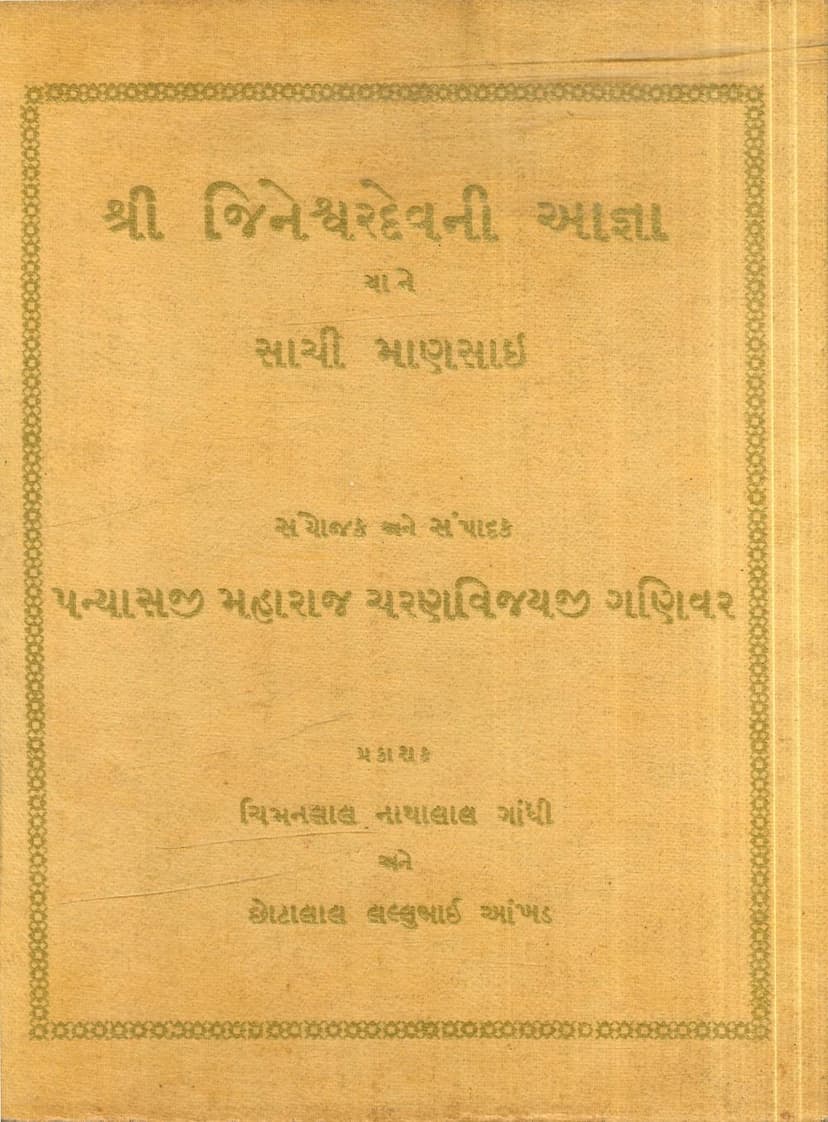Jineshwar Devni Aagna Yane Sachi Mansai
Added to library: September 2, 2025

Summary
Here is a comprehensive summary of the Jain text "Jineshwar Devni Aagna Yane Sachi Mansai" by Charanvijayji, based on the provided pages:
Book Title: Jineshwar Devni Aagna Yane Sachi Mansai (The Command of Lord Jinendra, Which is True Humanity) Author: Acharya Chandravijay Ganivara Shri Charamvijayji Publisher: Chimanlal Nathalal Gandhi Catalog Link: https://jainqq.org/explore/023268/1
Core Theme: The book, "Jineshwar Devni Aagna Yane Sachi Mansai," by the revered Acharya Charamvijayji, aims to explain the profound meaning of Jain teachings, particularly the command of Lord Jinendra, as the path to true humanity. It delves into the principles of Jainism and their practical application in life, emphasizing the importance of righteousness, compassion, and adherence to the Tirthankaras' teachings for spiritual and societal well-being.
Key Aspects and Content:
-
Title and Concept: The title itself signifies that the true path to humanity lies in following the commands of Lord Jinendra (the Jinas). This suggests a focus on ethical conduct, spiritual discipline, and the ultimate goal of liberation inherent in Jain philosophy.
-
Author and Publisher: The text is authored by Acharya Charamvijayji, a respected Jain scholar, and published by Chimanlal Nathalal Gandhi, indicating a traditional and established background for the work.
-
Structure and Content (Implied from Table of Contents and Sample Pages): The provided pages, particularly the table of "Vishaydarshan" (Table of Contents), reveal a comprehensive approach to Jain principles. The book covers a wide array of topics, presented through narratives, verses (dohas, chaupais, gathas), and dialogues (question-and-answer format).
- Jineshwar Devni Aagna (The Command of Lord Jinendra): This is the foundational concept, explaining what the Jinas teach and why their commands lead to true humanity.
- Sachi Mansai (True Humanity): This aspect is explored through various stories and explanations, defining what constitutes genuine human behavior from a Jain perspective.
- Core Jain Principles:
- Ahimsa (Non-violence): This is a central theme, discussed extensively in relation to both subtle and gross forms of violence, and its pervasiveness in various aspects of life, including diet.
- Satya (Truthfulness): The importance of truth is highlighted, with discussions on when to speak truth and when silence is more appropriate (e.g., in situations where truth might cause harm).
- Brahmacharya (Celibacy/Chastity): The text emphasizes the significance of controlling senses and desires, especially in marital and non-marital contexts.
- Aparigraha (Non-possession/Non-attachment): While not explicitly detailed in the provided snippets, the concept of detachment is implied through the examples of renunciation discussed in various stories.
- Ethical Conduct and Social Values: The book emphasizes:
- Family Harmony (Samp): Stories illustrate the importance of unity within families and the destructive nature of discord.
- Respect for Elders: The text stresses the importance of obeying parents and elders, citing examples from Jain history and mythology.
- Social Harmony: Adherence to community norms and the role of caste (jnati) are discussed in the context of maintaining social order and mutual support.
- Honesty and Integrity: The importance of ethical dealings in business and personal life is highlighted.
- Religious Practices and Beliefs:
- Panch Parmeshthi: The text begins with a salutation to the five supreme beings (Arhat, Siddha, Acharya, Upadhyay, Sadhu), reflecting the devotional aspect.
- Aavashyak Kriya (Six Essential Duties): Mentioned as daily practices for Shravakas (lay followers).
- Vows (Vrata): The text discusses various vows for lay followers, including the importance of adhering to them strictly.
- Tapas (Austerities): Different types of austerities are mentioned as crucial for spiritual progress.
- Deity Worship (Devpuja): The concept of worshipping Jineshwara/Tirthankaras is present.
- Gurus and Spiritual Teachers: The role of learned and virtuous preceptors is emphasized, along with the critical importance of following their guidance.
- Narratives and Examples: The book is rich with stories and parables, illustrating Jain ethical principles. These include:
- Stories of kings and queens (e.g., King Dasharatha, Ram, Bharat, Krishna, Baldev, Vikramaditya, Malva King Chandapradyota, King Datt, King Shantanu, King Dushyant, King Ashoka, King Kunwarpal).
- Stories of great souls and ascetics (e.g., Acharya Charamvijayji's own journey, Muni Arniak, Muni Dhannasharma, Muni Vardhamansuri, Muni Arhats, Muni Sanghamitra, Muni Sidhantpal, Muni Abhaydevsuri, Muni Kalaksurimaharaj, Muni Dhannapala).
- Stories of virtuous women (e.g., Mata Sita, Draupadi, Rani Chenna, Rani Anjana, Rani Sunanda, Rani Ranakdevi, Rani Liladevi, Rani Madalasa, Rani Sunanda, Rani Chandramati, Rani Nalini, Rani Sulochana, Rani Bhama, Rani Bhama).
- Discussions on the consequences of actions (karma), virtue (punya), and vice (pap).
- Explanations of complex Jain philosophical concepts like the nature of the soul, karma, the cycle of birth and death, and liberation.
- Critique of Other Beliefs/Practices: The text engages in dialogues and comparisons, particularly contrasting Jain principles with those of other religions, often highlighting perceived shortcomings like violence or flawed interpretations of divinity, particularly in relation to the concept of Ishvara (God) as a creator.
- Importance of Reasoning and Understanding: The text advocates for understanding the underlying principles (Anekantavada, Syadvada) rather than blind adherence, encouraging readers to analyze and test teachings.
- Support for the Publication: Page 5 and 6 list numerous donors, indicating significant community support for the publication of this extensive work, which reinforces the idea that it's a valuable resource for the Jain community.
Overall Tone and Purpose: The book appears to be a comprehensive guide to living a virtuous and spiritually fulfilling life according to Jainism. It uses a blend of scripture, logic, historical and mythological anecdotes, and poetic verses to convey its message. The author's intention is to guide readers towards "true humanity" by understanding and practicing the teachings of Lord Jinendra. The detailed table of contents suggests a deep dive into various aspects of Jain philosophy and ethics, making it a potentially influential text for spiritual seekers and lay followers.